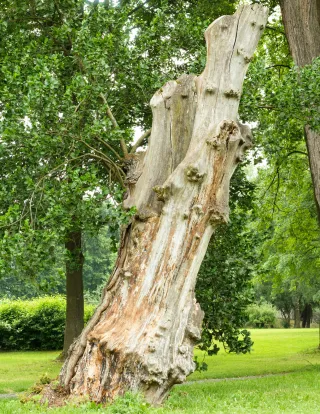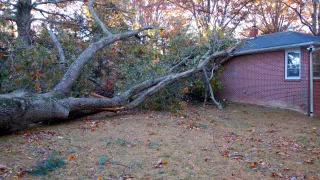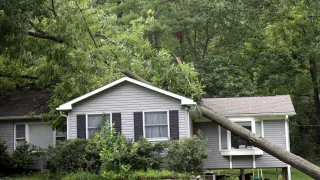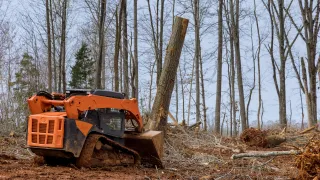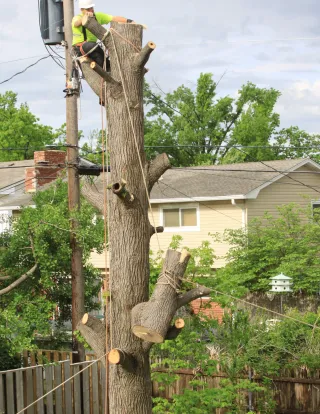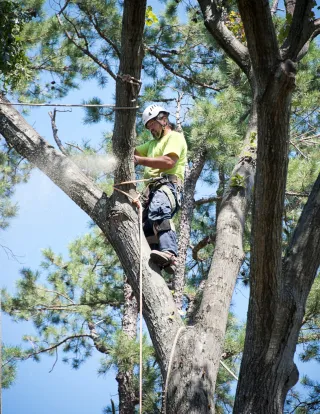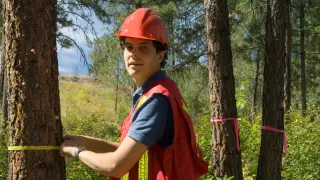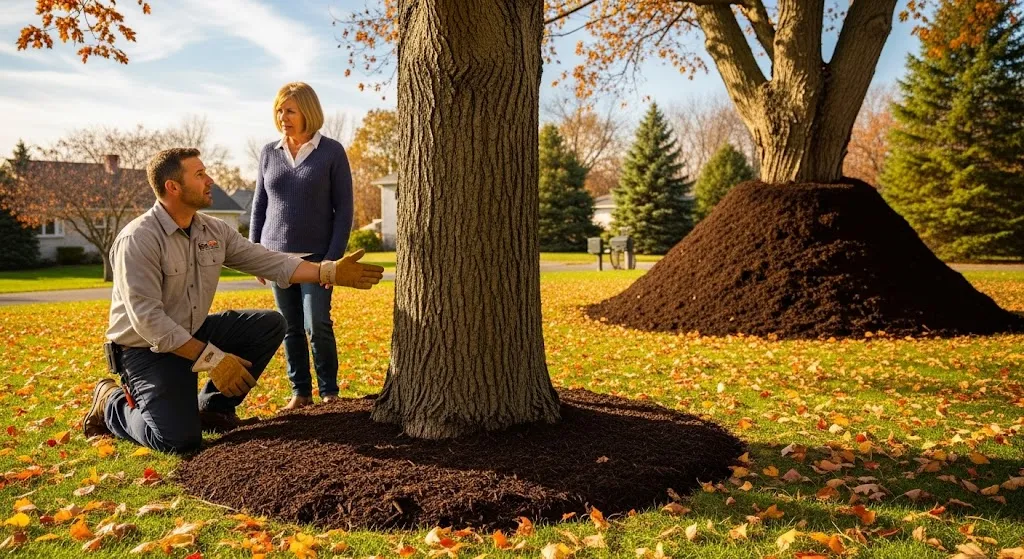
Fall Mulching: The Right Way to Prep Your Trees for Winter
Fall mulching is one of those things that seems simple until you start doing it wrong. I've seen homeowners pile mulch against tree trunks like miniature volcanos, thinking they're helping, and I've seen others skip mulching entirely because they heard it causes problems. The truth is that proper fall mulching helps trees survive winter stress, but the details really matter.
Why Fall Mulching Helps
Temperature moderation – Mulch insulates soil, preventing the freeze-thaw cycles that can damage shallow roots. In Tennessee, where winter temperatures can swing dramatically, this protection is especially valuable.
Moisture retention – Fall and winter can be surprisingly dry, and mulch helps soil retain whatever moisture is available. Trees continue to need water even when dormant.
Root protection – Young roots that grew near the surface during the growing season are vulnerable to freezing without insulation.
Weed suppression – Fall mulching prevents cool-season weeds from establishing around trees, reducing competition for water and nutrients.
Organic matter addition – As mulch breaks down over winter, it improves soil structure and feeds beneficial soil organisms.
The Mulch Volcano Problem
Piling mulch against tree trunks is probably the most common mulching mistake I see. It looks neat and tidy, but it creates serious problems:
Moisture retention against bark encourages rot and disease in the trunk area where trees are most vulnerable.
Pest habitat – Rodents and insects use mulch piled against trunks as nesting areas, and many of them damage bark while they're there.
Root problems – Roots may grow up into the mulch layer instead of spreading properly through soil, creating structural issues.
Trunk girdling – Roots growing in mulch can eventually wrap around the trunk, slowly strangling the tree.
The right approach: Keep mulch 3-6 inches away from tree trunks. Think donut, not volcano.
How Much and How Deep
2-4 inches of mulch depth is ideal for most situations. More than that can create problems with air and water movement. Less than that doesn't provide much benefit.
Mulch diameter should extend to the drip line (the outer edge of the tree's canopy) if possible, but even a 3-4 foot circle around young trees helps significantly.
For mature trees, you don't need to mulch the entire root zone – most of the benefit comes from mulching the area where feeder roots are most concentrated, usually within 6-8 feet of the trunk.
Choosing the Right Mulch
Organic mulches work best for fall application because they break down over winter and improve soil:
Shredded hardwood – readily available, looks neat, breaks down at a good rate
Wood chips – last longer than shredded mulch, good for areas where you don't want to re-mulch frequently
Pine straw – works well for acid-loving trees, stays in place on slopes
Composted leaves – excellent if you have a supply, but make sure they're properly composted
What to avoid: Fresh wood chips from treated lumber, cypress mulch that's been dyed, or anything that might contain chemicals harmful to trees.
Timing for Fall Mulching
Early to mid-fall (October-November) is ideal timing. You want to get mulch down before ground temperatures drop significantly, but not so early that it interferes with trees' natural preparation for dormancy.
After leaf drop is often good timing because you can see exactly where the tree canopy extends and mulch accordingly.
Before the first hard freeze ensures that soil temperatures are moderated before they start dropping toward winter lows.
Preparing the Area
Remove weeds and grass from the mulching area if possible. You don't need to be perfect about this, but reducing competition helps.
Don't till or disturb soil excessively – tree roots are often closer to the surface than people realize, and damage from cultivation can outweigh mulching benefits.
Check for existing mulch that might need refreshing rather than adding to. If you have 2+ inches of mulch that's still intact, you might just need to fluff it up rather than add more.
Address drainage issues before mulching. Mulch over poorly drained soil can create soggy conditions that harm roots.
Special Considerations for Different Trees
Young trees benefit more from mulching than established trees because their root systems are still developing and more vulnerable to environmental stress.
Newly planted trees should get mulch at planting time, but check that it's not too deep and hasn't been piled against the trunk.
Evergreens benefit from fall mulching just like deciduous trees, though they're often overlooked because they don't drop leaves to remind you it's mulching season.
Trees in turf areas often need mulch most because grass competition is so intense, but expanding mulched areas gradually prevents shock to established lawn areas.
What About Using Fallen Leaves?
Fallen leaves can make excellent mulch if handled properly:
Shred or chop leaves before using them as mulch – whole leaves can mat down and prevent air and water movement.
Don't use diseased leaves as mulch around the same species they fell from – this can spread disease problems.
Mix leaf mulch with other materials if you have large quantities – pure leaf mulch sometimes creates dense layers that roots can't penetrate.
Compost leaves first if you have time and space – composted leaf mulch is more stable and provides better long-term benefits.
Mulching Around Existing Landscaping
Work around existing plants rather than trying to create perfect circles – tree health is more important than geometric precision.
Coordinate with other landscape maintenance – fall mulching works well with other autumn garden cleanup activities.
Consider drainage patterns when extending mulched areas – you don't want to direct water toward foundations or create soggy spots.
Plan for spring maintenance – mulch breaks down over winter, and you'll likely need to refresh it in spring.
Common Fall Mulching Mistakes
Using fresh wood chips from diseased trees – these can introduce problems to healthy trees.
Mulching too late – if the ground is already frozen, mulch won't provide as much benefit.
Mixing mulch with fertilizer – fall isn't the time for stimulating new growth, and fertilizer can interfere with dormancy preparation.
Ignoring slope and drainage – mulch can redirect water flow in ways that cause problems if you're not paying attention.
Maintenance Through Winter
Check mulch periodically through winter, especially after storms that might have displaced it.
Don't pile snow on mulched areas if you can avoid it – heavy, wet snow can compact mulch and reduce its effectiveness.
Watch for animal damage – if rodents are nesting in mulch, you may need to pull it back from tree trunks temporarily.
Plan for spring refresh – most organic mulch breaks down significantly over winter and needs replacement or supplementation in spring.
Cost and Sourcing Considerations
Buy mulch in bulk if you're mulching multiple trees – it's usually much cheaper than bags.
Local sources often work best – municipal composting programs, tree services, and landscape suppliers usually have appropriate materials.
Quality matters more than price – cheap mulch that contains weed seeds or chemicals can create more problems than it solves.
Consider making your own if you have adequate space and fallen leaves – it takes time but can be very economical.
Integration with Other Tree Care
Fall mulching works well with other autumn tree maintenance – pruning, fertilizing (if appropriate), and general cleanup.
Coordinate timing with other landscape work to minimize multiple disruptions to the same areas.
Plan mulching around irrigation systems – make sure mulch doesn't interfere with sprinkler coverage or create drainage problems.
Environmental Benefits
Proper mulching reduces water needs through improved retention and reduced evaporation.
Organic mulch supports beneficial soil organisms that contribute to overall soil health.
Using local organic materials reduces waste and transportation impacts.
Healthier trees provide better environmental services – air cleaning, carbon storage, and wildlife habitat.
The Bottom Line
Fall mulching is one of the most beneficial things you can do for your trees, but technique matters as much as timing. Proper depth, appropriate materials, and keeping mulch away from trunks make the difference between helping and harming your trees.
The investment in fall mulching pays off in healthier trees, reduced water needs, and fewer problems with weeds and soil compaction.
If you're dealing with large trees, difficult access, or just want to make sure you're doing mulching right, professional help can ensure you get the benefits without the common problems. Give us a call or text at (423) 443-4533 – we can help with mulching as part of comprehensive fall tree care or answer questions about doing it yourself effectively.


